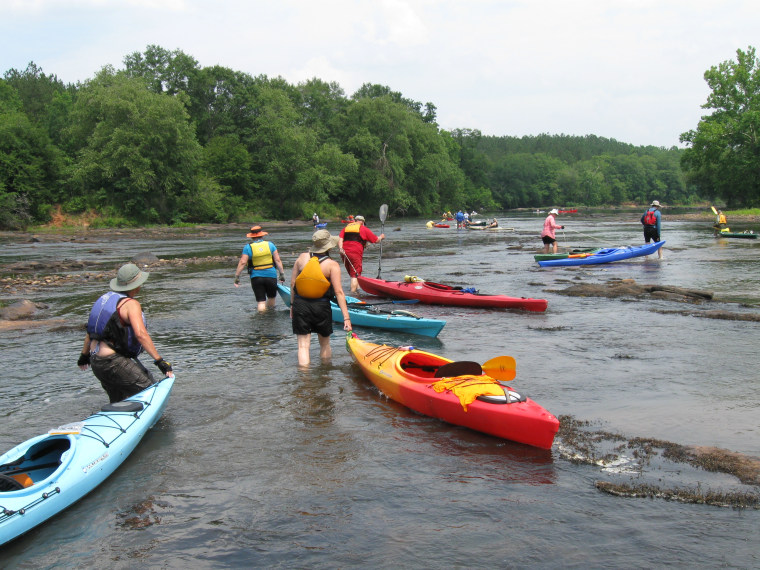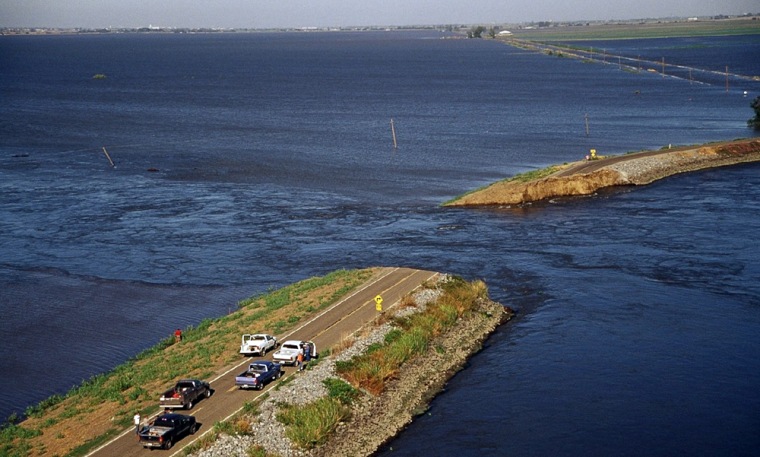California's two longest rivers were listed Tuesday as the country's "most endangered" waterways in 2009 because of outdated water management and poor flood planning.
American Rivers, a conservation group that compiles the annual list, chose the Sacramento and the San Joaquin rivers because their collapse could endanger the water supply of 25 million Californians, flood the state's capital and damage the delicate freshwater delta where the two rivers twine.
"The health of the delta depends directly on maintaining the health of these two rivers that feed it," said Steve Rothert, California director of the Washington-based nonprofit.
The organization chooses its most endangered rivers from nominations made by environmental groups and considers the value of each river to people and the environment, the level of the threat it faces and pending decisions that could affect it in the next year, Rothert said.
But Jerry Johns, deputy director at California's Department of Water Resources, said the report did not give adequate consideration to statewide efforts to restore the health of the delta and its two chief tributaries.
Rivers from Pennsylvania to Alaska also made this year's list. Rounding out the top five were Georgia's Flint River, the Lower Snake River that courses through Idaho, Washington and Oregon, Mattawoman Creek in Maryland and the North Fork of the Flathead River in Montana.
One recent political compromise will help restore a now-dry 60-mile stretch of the San Joaquin River.
Last week, President Barack Obama signed a wilderness bill that implements a 2006 legal settlement to bring water and Chinook salmon back to a portion of the state's second-longest river. It provides about $390 million in federal and state funds, as well as fees from water users, over the next decade.

The lawsuit stemmed from the opening of Friant Dam in 1949, which transformed the San Joaquin Valley's main artery from a river thick with salmon into an irrigation source for more than a million acres of farm fields.
Under the 2006 settlement, irrigation districts that distribute river water to thousands of farms agreed to relinquish a set portion of their traditional water supplies to help restore the fish.
American Rivers listed these as the most endangered rivers, and provided the background information with each:
#1: Sacramento-San Joaquin River System (Calif.)
Threat: Outdated water and flood management
"The largest watershed in California is on the verge of collapse, threatening the water supply for more than 26 million people, placing the capital of the nation’s most populous state at high risk of flooding, and damaging a once productive and healthy ecosystem that supported the nation’s most diverse salmon runs," American Rivers said. "Climate change, population growth, water supply demands, and endangered species listings have brought this outmoded water and flood management system to the brink. The California Department of Water Resources, and their federal partners, the Bureau of Reclamation and Army Corps of Engineers, are undertaking an overhaul of water management in the basin. Rather than repeating the mistakes of the past, such as building more and larger levees and dams, they need to invest in sustainable options that protect water supply, farms, and cities, while restoring the health of these great rivers and their estuary."
#2: Flint River (Ga.)
Threat: Proposed water supply dams
"Well loved by anglers, boaters and Georgia families, the Flint River is one of the state’s most valuable natural treasures," American Rivers said. "But a two-year drought in the Southeast has revived calls to dam the Flint, even though more effective water supply solutions would save Atlanta as much as $700 million. Congress must deny attempts to authorize new dams on the Flint, and Metro Atlanta must institute water efficiency measures to lower its water use."
#3: Lower Snake River (Wash., Ore., Idaho)
Threat: Four dams
"Four dams on the lower Snake River have caused dramatic declines in the Snake River basin’s once magnificent salmon runs and have stymied efforts to restore these fish," American Rivers said. "Removing the four dams and restoring a free-flowing lower Snake River will not only revive the salmon runs and a multi-million dollar fishery, it will eliminate a growing flood threat in Lewiston and create an opportunity to modernize the region’s transportation and energy systems. The Obama administration and the Northwest congressional delegation must convene negotiations to forge a river restoration plan that will work for communities and salmon in light of the threats posed by the dams and global warming."
#4: Mattawoman Creek (Md.)
Threat: Highway and poorly planned development
"Mattawoman Creek is one of the few tidal, freshwater tributaries to the Chesapeake Bay that remains healthy and unspoiled," American Rivers said. "Although Maryland’s Department of Natural Resources has concluded that Mattawoman should be protected from overdevelopment, a proposed highway in Charles County threatens the creek’s clean water and popular fishing and recreation opportunities. Unless the Maryland Department of the Environment and U.S. Army Corps of Engineers deny a key wetland permit for the proposed highway, Maryland will lose this treasured creek and the goal of a healthy Chesapeake Bay will slip further from reach."
#5: North Fork of the Flathead River (Mont.)
Threat: Mining
The "North Fork of the Flathead River is a magical place of exceptional wilderness value that has seen only limited development," American Rivers said. "In the United States, the North Fork is one of the best-protected watersheds in the country. But the river remains unprotected where it originates in British Columbia, and mining and industrial coalfield development proposals threaten the entire river downstream. The U.S. State Department must keep President Obama’s campaign commitment to oppose mining in the headwaters of the North Fork. The State Department must strongly urge British Columbia to extend permanent protections for the river and stop harmful mining proposals that would spoil this international treasure."
#6: Saluda River (S.C.)
Threat: Sewage pollution
"The drinking water source for more than 500,000 people and a hot spot for boaters and anglers, the Saluda River is choking from phosphorous pollution found in human waste," American Rivers said. "Wastewater treatment plants are dumping excessive amounts of phosphorous into the river, which is threatening property values, fish and wildlife, and public health. The South Carolina Department of Health and Environmental Control must impose meaningful phosphorous limits on all wastewater treatment plant permits to protect the health of the Saluda River and communities that depend on it."
#7: Laurel Hill Creek (Pa.)
Threat: Excessive water withdrawals
"Laurel Hill Creek is a Pennsylvania treasure that brings valuable recreation and tourism dollars to local communities," American Rivers said. "But the creek lacks safeguards to protect it from excessive water withdrawals for development and energy extraction. Unless water planners heed the sound water management advice in Pennsylvania’s new State Water Plan, water withdrawals could irreparably harm the clean water, fish and wildlife and recreation here and downstream on the popular Youghiogheny River."
#8: Beaver Creek (Alaska)
Threat: Oil and gas development
"Beaver Creek is a wilderness gem, home to abundant salmon and other wildlife, and a spectacular destination for anglers, boaters, skiers, and hunters who seek its solitude," American Rivers said. "But Beaver Creek’s wild character may soon be traded for oil and gas development by the very agency mandated to protect it—the U.S. Fish and Wildlife Service. Although the creek is enveloped within three national conservation areas, a secretly-negotiated deal to transfer protected lands into corporate hands initiated under the Bush Administration could result in the proliferation of hundreds of miles of roads, pipelines, airstrips, and drilling wells that would cause irreparable harm to the creek and threaten the Yukon River downstream. The USFWS, under new leadership, must halt this misguided project and protect the people and businesses that depend on a healthy Beaver Creek."
#9: Pascagoula River (Miss.)
Threat: New petroleum storage
"Mississippi’s 'Singing River' flows freely through the heart of the state’s ancient bottomland swamps before reaching the Gulf in a rich network of channels and bayous," American Rivers said. "The Pascagoula is an important nursery for fish and wildlife and supports a fishing industry worth hundreds of millions of dollars. But this natural treasure could be lost if the U.S. Department of Energy uses the river to hollow out natural salt domes for future storage of 160 million barrels of oil as part of a project initiated under the Bush Administration. The Obama Administration and key members of Congress should deny this misguided project that would waste taxpayer dollars on outdated oil infrastructure and threaten the clean water and health of the Pascagoula, and instead focus efforts on reducing the nation’s dependence on oil."
#10: Lower St. Croix National Scenic Riverway (Minn., Wis.)
Threat: Loss of Wild and Scenic Protections
"The Lower St. Croix National Scenic Riverway provides a rare natural retreat in a growing urban area," American Rivers said. "It is a favorite destination for boaters, anglers, and families seeking a natural, outdoor experience. Recreation dollars provide a healthy boost to the regional economy. But the state-managed section of this Wild and Scenic gem is in danger. Short-sighted zoning decisions along a 26-mile stretch of this protected river threaten to damage the very qualities that make the river so special and appealing to residents and visitors. Minnesota and Wisconsin must renew their commitment to the Lower St. Croix and work with riverfront counties, municipalities, and townships to ensure development is responsibly planned, so that the river remains protected for future generations."
